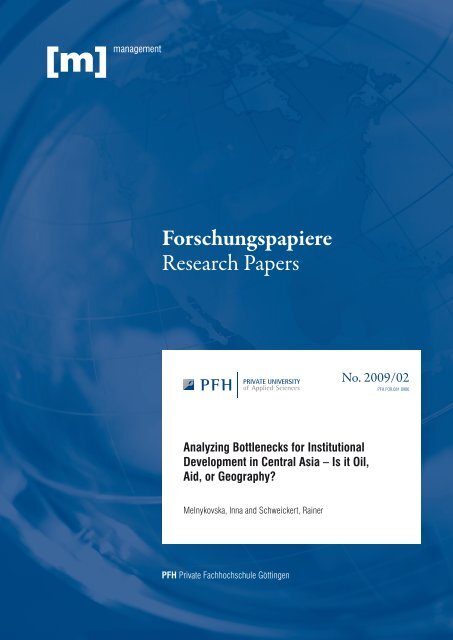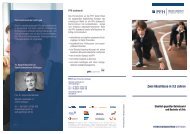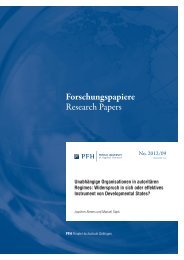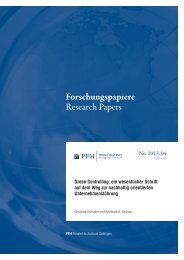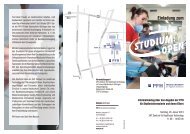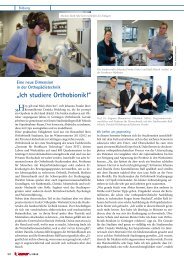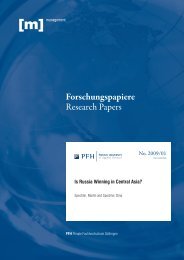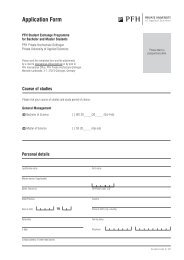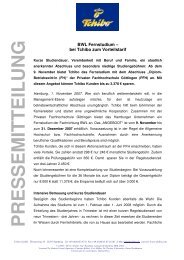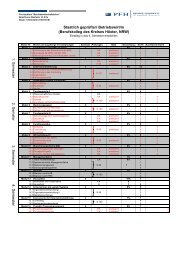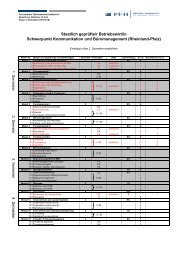View - PFH Private Hochschule Göttingen
View - PFH Private Hochschule Göttingen
View - PFH Private Hochschule Göttingen
You also want an ePaper? Increase the reach of your titles
YUMPU automatically turns print PDFs into web optimized ePapers that Google loves.
[m] management<br />
Forschungspapiere<br />
Research Papers<br />
No. 2009/02<br />
<strong>PFH</strong>.FOR.081.0906<br />
Analyzing Bottlenecks for Institutional<br />
Development in Central Asia – Is it Oil,<br />
Aid, or Geography?<br />
Melnykovska, Inna and Schweickert, Rainer<br />
<strong>PFH</strong> <strong>Private</strong> Fachhochschule Göttingen
Forschungspapiere Research Papers | 2009/02<br />
Lebenslauf<br />
Curriculum Vitae<br />
Dr. Rainer Schweickert is Research Fellow at the Kiel Institute for<br />
the World Economy. He studied at the University of Mannheim<br />
and received his PhD at the University of Kiel in 1993. He has<br />
been head of the research division ‘Stability and Structural Adjustment’<br />
and of the project area ‚Beyond Europe‘ and published<br />
on macroeconomic issues and economic development with a<br />
special focus on monetary policy, regional integration, and institution<br />
building in emerging market and transition economies.<br />
Currently, he coordinates the Kiel Institute’s workpackages in<br />
the EU-financed project ENEPO (EU Eastern Neighborhood –<br />
Economic Potential and Future Development).<br />
Inna Melnykovska is Research Fellow at the Kiel Institute for<br />
the World Economy and a PhD student at the Otto-Suhr Institut<br />
for Political Sciences, Free University (Berlin). She earned her<br />
Diploma in Economics at Ternopil Academy of National Economy<br />
and a Master’s Degree in International Relations at the<br />
Institut of International Relations, Kyiv State University (Ukraine).<br />
She works in the workpackage “Institutional Convergence<br />
CIS towards European Banchmarks” in the EU-financed project<br />
ENEPO (EU Eastern Neighbourhood – Economic Potential and<br />
Future Development) and in the project on NATO’s impact in<br />
transition countries financed by the Fritz-Thyssen-Foundation.<br />
She is doing research on issues of political economy related<br />
to Eastern Europe, e.g. external and internal determinants of<br />
institution building and good governance, the role of economic<br />
actors in politics and policy-making, democracy-oriented and<br />
sectoral Europeanisation, and institutional convergence (EU,<br />
WTO, and NATO’s approaches).
Analyzing Bottlenecks for Institutional Development in Central Asia –<br />
Is it Oil, Aid, or Geography?*<br />
Inna Melnykovska and Rainer Schweickert<br />
Kiel Institute for the World Economy<br />
Abstract: The quality of institutions is considerable worse in Central Asia than in other transition<br />
countries. Based on a panel of 25 transition countries for the period from 1996 to 2005, this paper<br />
shows that oil and aid exert a negative influence on institutional development. At the same time,<br />
transition countries benefited from external incentives due to cultural proximity to the West or a<br />
membership perspective in either EU or NATO. However, the evaluation for Central Asia reveals that<br />
aid, oil, and geography explain part of the backlog but, even accounting for the fact that the countries<br />
are “far away” and do not benefit from external incentives as do other transition countries, there is a<br />
strong and homogenous negative regional component of bad governance. Hence, change might come<br />
but at a very low pace.<br />
Keywords: EU, NATO, Transition Economies, Institutional Change, Governance, Central Asia<br />
JEL-Classification: F15, F20, F50, P20, P30, O19<br />
Corresponding author:<br />
Rainer Schweickert<br />
Kiel Institute for the World Economy<br />
Duesternbrooker Weg 120<br />
24105 Kiel, Germany<br />
Telephone: +49-431-8814-494<br />
E-mail: rainer.schweickert@ifw-kiel.de<br />
* This paper is an output from the ENEPO project on EU Eastern Neighbourhood: Economic Potential and<br />
Future Development financed by the EU in the Sixth Framework Programme. The authors thank the participants<br />
of the conference “Institutions, Institutional Change, and Economic Performance in Central Asia”, organized by<br />
the <strong>Private</strong> University of Applied Sciences Göttingen on 25-26 September 2008, for helpful comments. We<br />
would also like to thank Hanno Heitmann for his excellent technical assistance.
1. Introduction<br />
As has been exemplified by the case of the Eastern Enlargment of the EU, external drivers can<br />
speed up the convergence of weak governance structures towards Western standards<br />
considerably. The EU has indeed been successful in promoting democracy and economic<br />
development by fostering institution building in most central and eastern European transition<br />
countries (Roland 2006). Europeanization, i.e. the adoption of EU rules by transition<br />
countries, is possibly “the most massive international rule transfer in recent history”<br />
(Schimmelpfennig and Sedelmaier 2005). This top-down process of “Enlargement<br />
Europeanization” has been guided by the Copenhagen criteria for accession to the EU which<br />
demand the fulfillment of comprehensive political, legal and economic criteria (Foders et al.<br />
2002).<br />
However, after the Eastern enlargement has been completed with the recent accession of<br />
Bulgaria and Romania in 2007, the “carrot” of membership for pushing institutional<br />
development in transition countries is at present exclusively reserved for the Western Balkan<br />
states. For FSU (Former Soviet Union republics, except the Baltic States) as well as for<br />
Mediterranean countries, European Neighborhood Policy (ENP) foresees support from the EU<br />
conditional on performance according to governance criteria. Nevertheless, compared to the<br />
big carrot of membership, ENP incentives may be too limited in order support internal drivers<br />
of institutional reform (Vinhas de Souza et al. 2006). For FSU countries in Central Asia,<br />
incentives for “Neighbourhood Europeanization” can be assumed to be even lower (Gawrich<br />
et al. 2008).<br />
Table 1 reveals that relations of Central Asian transition countries with either EU or WTO<br />
and NATO are at a very early stage. Only Kazhakhstan, the Kyrgyz Republic, and Uzbekistan<br />
benefit from Partnership and Cooperation Agreements (PCAs) which have been ratified by<br />
the EU. These agreements date back to 1999, the year when PCA agreements have been<br />
concluded for the Caucasus countries as well. Different to Central Asian countries the latter<br />
group of countries reached a somewhat closer relationship with the EU recently. For<br />
Tajikistan and Turkmenistan, PCA agreements have not been ratified by the EU. The same<br />
applies when looking at WTO and NATO integration. Only the Kyrgyz Republic became a<br />
member of WTO in 1998 and only Kazakhstan moved from a Partnership for Peace (PfP)<br />
agreement with NATO, which is a standard for all transition countries including Russia, to an<br />
Individual Partnership Action Plan (IPAP) agreement in 2006.<br />
1
In addition, Central Asian countries are not only far away from the Western community<br />
(and close to China and Russia for that matter), but are characterized by large inflows of<br />
resources either steming from oil or aid (Promfret 2006; Spechler 2008a). Hence, while not<br />
benefiting from close relations with the West, Central Asian countries also face the difficulty<br />
of fighting potential disincentive effects from resource curse effects. As long as financial<br />
inflows stemming from these sources “grease the wheels” and, at least for some years, create<br />
high growth rates the need for reforms is difficult to establish. In addition, big money is likely<br />
to create more corruption which renders it difficult to develop productive activities in a<br />
competitive environment.<br />
Indeed, a first comparison with other transition countries reveals a rather low development<br />
of institutions in these countries. Table 2 presents indicators on institutional quality which<br />
have been standardized and which highlight different aspects of institutional quality. While<br />
the Freedom House indicator shows political rights and civil liberties and, hence, concentrates<br />
on the democracy aspect, the Heritage and EBRD indices reveal the quality of administrative<br />
and economic institutions. Finally, the World Bank Governance Indicators (WBGI) represent<br />
a more comprehensive view on institutional quality including legislative, administrative, and<br />
legal aspects. It is evident from the table that Central Asia, together with Belarus clearly hold<br />
the red lantern with respect to institutional quality. The only exception is economic freedom<br />
as measured by the Heritage index which has Tadjikistan above FSU average. This supports<br />
the hypothesis that institutional development may be rather difficult in the absence of external<br />
drivers providing carrots and sticks as was the case in “Enlargement Europeanization”.<br />
However, the empirical evidence on external drivers of institutional change in transtition<br />
countries is rather limited. Recent papers focus mainly on internal economic, political, and<br />
cultural factors (Di Tommaso, Raiser, and Weeks 2007; Beck and Laeven 2006) treating an<br />
EU influence rather as a control variable than as a main determinant of institutional change.<br />
Hence, this paper fills an empirical gap by focusing on external influences and analyzing the<br />
influence of different international organizations European transition countries may join.<br />
These organizations often provide positive incentives for improving institutions. While papers<br />
analyzing the impact of trade relations include WTO membership (see, e.g., Bacchetta and<br />
Drabek 2004) and also the impact of the EU has received extensive attention, the accession to<br />
NATO as a determinant of institutional change has not. NATO membership has been mostly<br />
analyzed with respect to economic aspects of regional security (e.g. Sandler and Hartley<br />
1999).<br />
2
The paper shows that natural resources and capital inflows exert an insignificant or<br />
negative influence and that economic policy allows to break path-dependency. At the same<br />
time, transition countries benefited from external incentives provided from both EU and<br />
NATO. Below a membership perspective, ENP and NATO-MAP provide trade and security<br />
incentives respectively. This allows to assess the situation of the Central Asian countries in<br />
contrast to comparable FSU countries which may benefit (more) from external incentives.<br />
Section 2 gives a short overview of the existing literature which presents the theoretical<br />
arguments. Results from panel estimations for 25 transition countries for the period from 1996<br />
to 2005 based on the World Bank Governance Indicators, the most comprehensive measure<br />
for institutional quality publicly available, are shown in section 3. Section 4 summarizes and<br />
draws policy conclusions for Central Asian FSU countries.<br />
2. Empirical Evidence on External Drivers of Institutional Change<br />
A political economy explanation of why institution building has varied so much across<br />
transition countries which are resource rich like Kazakhastan and Turkmenistan, and, to a<br />
lesser extent, Uzbekistan is provided by Beck and Laeven (2006). They argue that political<br />
entrenchment and reliance on natural resources critically determine whether the behavior of<br />
the ruling elite and thus the transition process are catalytic or extractive. While this seems to<br />
support the pessimistic view that initial conditions determine future outcomes (Fish 1997;<br />
Kopstein and Reilly 2000; Guiso et al. 2006; Zweynert 2006), there is also a more optimistic<br />
view on the potential for institutional progress in rent-seeking societies which links<br />
economics and politics. Olson (2000) argues that the availability of short-term rents like nonrenewable<br />
resources provides the basis for the rent-seeking strategy of “roving bandits”, but<br />
that “roving bandits” could transform into “stationary bandits” after having reached the limits<br />
of their capacities to accumulate and control the wealth on the basis of informal institutions<br />
(see also Tornell 1998; Dixit, Grossman and Helpman 1997).<br />
Concerning the influence of resource endowment on institution building, plenty of studies<br />
suggest that the adverse effect of resource abundance on institutional quality is particularly<br />
strong for easily accessible ‘point-source’ natural resources with concentrated production and<br />
revenues and thus massive rents, i.e., oil, diamonds, minerals and plantation crops rather than<br />
agriculture (e.g., rice, wheat and animals) whose rents are more dispersed throughout the<br />
economy, and with easy appropriation of rents through state institutions (Auty, 1997, 2001;<br />
Isham, et. al., 2005; Sala-i-Martin and Subramanian 2003; Murshed, 2004; Collier and<br />
3
Hoeffler 2004; Ploeg 2007). Analyzing the political economy of resource-driven growth in<br />
the FSU countries, Auty (2001; 2006) finds that most resource-abundant countries engender a<br />
political state that is factional or predatory and whose government responds slowly to the<br />
challenges of economic reforms, distorts the economy in the pursuit of rents that are deployed<br />
to force industrialization and this leads to a staple trap. The negative influence is explained<br />
with rent-seeking behavior and lower pressure for political reform. In contrast, other natural<br />
resources, measured for example as the share of agriculture in GDP, are not found to have a<br />
negative influence.<br />
For Tajikistan and the Kyrgyz Republic large scale inflows of financial resources are rather<br />
coming from aid than natural resources. Hence, aid may create similar disincentive effects for<br />
improving institutional quality. As shown in the literature, the allocation of aid has become<br />
more selective in recent years, and has become more responsive to economic fundamentals<br />
and the quality of a country’s policy and institutional environment (Claessens, Cassimon, and<br />
von Campenhout 2007). Hence, aid should support institutional change. However, a potential<br />
problem with aid inflows is created by their direct impact on government behavior. By<br />
expanding a government’s external resources, foreign aid can weaken institutions by reducing<br />
accountability. Evidence suggests that industries which are more sensitive to bad governance<br />
grow at a slower pace in countries that receive more aid (Rajan and Subramanian 2007).<br />
Another source of disincentives for Central Asian countries stem from the lack of potential<br />
external drivers of institutional change. The literature on external drivers of institutional<br />
change in transition countries is clearly dominated by research on EU-ization by means of<br />
accession and neighbourhood policy (see, e.g., Beck and Leaven 2006; Pop-Eleches 2007; Di<br />
Tommaso et al. 2007) and seems to confirm a positive impact of basic agreements between<br />
the EU and transition countries. 1 At the same time, a potential impact of NATO which has<br />
Partnership for Peace (PfP) agreements with all former Soviet countries is disregarded, except<br />
for economic aspects of enlargement on regional security (see, e.g., Sandler and Hartley 1999;<br />
Andrei and Teodorescu 2005). In its Membership Action Plan (MAP) approved at NATO’s<br />
Washington Summit in 1999, NATO accession requires a minimum of institutional standards.<br />
The “carrot” in this case is regional security rather than economic cooperation. Hence, it can<br />
be argued that NATO accession could have a positive effect which might be comparable to<br />
4
the impact of EU accession. In addition to the EU and NATO, the WTO may also provide<br />
major incentives for institution building. However, as reported in Busse et al. (2007)<br />
empirical studies largely fail to show a significant impact once trade flows are controlled for.<br />
In addition, some transition countries became WTO members long before entering the<br />
transformation process.<br />
Clearly, cooperation with EU and NATO seems not to be completely irrelevant for Central<br />
Asia, but further steps towards deeper integration are not in the cards or would provoke<br />
Russian resistance as witnessed by the conflict in Georgia. Therefore, proximity (to the West)<br />
can be assumed to matter in various dimensions (Way and Levitsky 2007; Vinhas de Souza et<br />
al. 2006).<br />
• Proximity to the West in terms of cultural norms is assumed to provide a significant pathdependency<br />
concerning institutional development (Di Tommasso, Raiser, and Weeks 2007;<br />
Kitschelt 2001; La Porta, Shleifer, and Vishny 1999). A society’s culture adapts rather slowly<br />
to changing economic circumstances because of a high persistence of cultural norms and<br />
human belief systems. At the same time, religious affiliation, like belonging to the community<br />
based on western Christianity, can be thought of as a proxy for a complex set of initial<br />
conditions.<br />
• Trade and capital flows may impact on the preconditions for institutional change through<br />
closer interaction with the outside world. Concerning trade flows, Busse et al. (2007) argue<br />
that any analysis on the relative impact of trade on income and growth suffers from a lack of<br />
relevant control variables, if important determinants of a successful trade liberalization, such<br />
as institutional quality affecting the reallocation of resources, are not included. Their results<br />
confirmed earlier work showing that more open economies tend to have better institutions<br />
(see, e.g. Wei 2002; Islam and Montenegro 2002; IMF 2005). For the FSU context,<br />
Havrylyshyn (2006) claims that openness and sweeping reforms have reduced social pain in<br />
Central Europe and the Baltic states. He suggests that liberalization and openness ensure<br />
economic recovery and democratic institutions.<br />
• Arguably, foreign direct investment (FDI) inflows may also help promote good governance in<br />
FSU countries. However, focusing on corruption, Hellmann, Jones, and Kaufmann (2002)<br />
show that foreign firms are more likely than domestic firms to pay kickbacks for public<br />
procurement contracts. Especially in countries where kickbacks are less common, foreign<br />
firms are more likely to engage in this form of corruption. In countries with a significant state<br />
capture problem, FDI firms are almost twice as likely as domestic firms to be engaged in<br />
efforts to capture the state. Hence, overall the presence of foreign firms seems to widen the<br />
gap between countries with good and countries with bad institutions.<br />
While a comprehensive empirical analysis of all relevant external drivers of institutional<br />
change in transition countries is still missing, the analysis of internal determinants can be<br />
based on a variety of papers. The basic distinction is between economic and political factors.<br />
1 While this finding would allow for some optimism regarding weak incentives provided by ENP, the paper by<br />
Di Tommaso et al. (2007) uses indicators from the EBRD for measuring institutional change in terms of<br />
5
The view that economic performance drives institutional development is supported by the<br />
modernization hypothesis which states that higher levels of economic development will lead<br />
to better institutional quality (see, e.g., Lipset 1959; Acemoglu et al. 2007). In the same vein,<br />
the Grand Transition view sees development as a process where steady economic growth<br />
causes transition of all institutions (Paldam and Gundlach 2008). However, economic shocks<br />
and macroeconomic crises may also be an important determinant of political transition<br />
(Acemoglu and Robinson 2006; Paldam 2002). These shocks give rise to a window of<br />
opportunity for citizens to contest power, as the cost of fighting ruling autocratic regimes is<br />
relatively low. When citizens reject policy changes that are easy to renege upon once the<br />
window of opportunity closes, autocratic regimes must make democratic concessions to avoid<br />
costly repression (see also Brückner and Ciccone 2008). Apart from economic performance,<br />
also economic policy is important for driving institutional change. Looking at the typical<br />
sequencing of reforms suggests that economic liberalization and privatization, as well as the<br />
granting of basic political rights and liberties, preceded institutional reforms such as the<br />
establishment of a competition authority and stronger financial market supervision. Hence,<br />
policy can to some extent break path-dependence through economic and political<br />
liberalization (Di Tommaso, Raiser, and Weeks 2007; Havrylyshyn 2006).<br />
All in all, there is established evidence on the importance of internal determinants of<br />
institutional change. However, any empirical analysis needs to condition on external<br />
determinants as well in order to avoid misspecification. For European and FSU transition<br />
countries, potentially relevant external factors comprise economic relations, proximity, and, at<br />
least to some extent, cooperation with EU and NATO.<br />
We test this hypothesis for 25 transition countries using a comprehensive measure of<br />
institutional quality, i.e. the World Bank Governance Indicators (WBGI). The WBGI are<br />
calculated as the sum of six single indicators as provided by the World Bank (Kaufmann et<br />
al., 2007). We argue that this is the most comprehensive measure of institutional development<br />
which is available for international comparisons. The WBGI include indicators on voice and<br />
accountability, political stability and absence of violence, government effectiveness,<br />
regulatory quality, rule of law, and control of corruption. Hence, the aggregate indicator<br />
economic institutions only. However, the Europeanization strategy of the EU is not restricted to a narrow<br />
concept of economic institutions but targets political and legal institutions as well.<br />
6
integrates legislative, administrative and legal aspects as well as political and economic<br />
institutions (Schweickert 2004).<br />
A variety of explanatory variables are employed not only in order to assess their<br />
coefficients but also to proxy for important and otherwise unobserved country characteristics<br />
as previously described. All explanatory variables and their data sources which have been<br />
employed are listed in Table A1 and the complete set of regressions is presented in<br />
Drautzburg et al. (2008). In the following, only the results from the baseline model are<br />
presented which followed from eliminating insignificant variables in the comprehensive<br />
model.<br />
Table 2 shows that both EU and NATO cooperation has a positive impact on the level of<br />
institutional quality in transition countries. EU BASIC is a dummy variable which takes the<br />
value of one in a country for each year after a Stabilization and Association Agreement (SSA)<br />
has been signed or a Partnership and Cooperation Agreement (PCA) came into force. This<br />
definition resembles that by Di Tommaso, Raiser and Weeks (2007). NATO MAP indicates<br />
whether a Membership Action Plan (MAP) has been established for a country. Proximity and<br />
interaction with western countries has an ambiguous effect. WESTERN indicates whether a<br />
country belongs to the western Christian community. These countries clearly have better<br />
institutions than other transition countries. At the same time, the negative coefficient of AID<br />
measuring aid inflows into transition countries supports arguments on rent-seeking behaviour<br />
rendering institutional reforms more difficult.<br />
Internal economic determinants include indicators of economic policy as well as economic<br />
performance. In line with Di Tommaso, Raiser, and Weeks (2007) we measure economic<br />
policy using the LIBERALIZATION indicator provided by the EBRD. Di Tommaso et al.<br />
found a positive impact on an aggregated EBRD indicator of institutions and we expect a<br />
similar impact on a broader concept of institutions not constructed by the EBRD itself. Table<br />
1 shows that this is indeed the case. In addition, LIBERALIZATION as well as NATO MAP<br />
are also significant in fixed effects regressions showing that economic reforms have a positive<br />
impact on institutional dynamics as well. Coefficients of internal political factors chosen to<br />
reflect both incentives for policy as well as initial conditions reveal the expected signs.<br />
COHESION reflecting whether the first post-communist government was relatively<br />
independent of the former communist party is a positive factor for institutional quality and<br />
TENSIONS, a dummy which measures whether the transition from communism involved<br />
conflicts, has a quite strong negative impact on institutions. This also applies to the<br />
7
availability of extractable resources as measured by the ENDOWMENT dummy and the<br />
MINERAL EXPORT variable.<br />
All in all, our results confirm the arguments raised in the literature on institutional change<br />
in developing and transition countries that oil, aid, and geography matter for institutional<br />
development. As will be shown next, this implies a heavy burden for institutional change in<br />
Central Asia, i.e. for countries which are either resource rich, have to handly large scale aid<br />
inflows, and, all of them, far away from well governed countries in the West. However, both<br />
internal and external actors can influence institutional development in transition countries<br />
positively. Internal actors can break path-dependencies through economic policy reforms,<br />
whereas both EU and NATO can have some positive impact even through basic cooperation<br />
agreements.<br />
3. Implications for Institution Building in Central Asia<br />
As can be seen in Figure 1, only Kazakhstan shows an above average of institutional quality<br />
compared to FSU countries. Initially, the same applied to Kyrgyzstan which, together with<br />
Uzbekistan shows a clear negative trend. In the case of Kyrgyzstan, the Tulip revolution in<br />
2005 brought an end to the deterioration of institutions under Akayev. The only country in<br />
Central Asia which improved institutional quality significantly since the mid-1990s is<br />
Tadjikistan albeit from a very low level if one considers that the “normal” range of the<br />
normally distributed WBGI index ranges between +/- 2.50. Additionally, the country suffered<br />
from civil war until 1997 and could only catch up later (see EIU var. iss.).<br />
All in all, the picture reveals some heterogeneity with institutions converging and<br />
stabilizing in recent years. In 2006, three groups of Central Asian countries could be<br />
distinguished: Kazakhstan – the only country above FSU average; Kyrgyzstan and Tajikistan<br />
slightly below FSU average; and Uzbekistan and Turkmenistan which did not only perform<br />
much worse than the other Central Asian countries but also reveal bad institutions on an<br />
absolute level. This supports the hypothesis that institutional development may be rather<br />
difficult in the absence of external drivers providing carrots and sticks as was the case in<br />
“Enlargement Europeanization”.<br />
Tables 4 and 5 provide some explanations for the heterogeneity of institutional quality in<br />
Central Asia. While all of them “benefit” from modest incentives due to the PCA agreements<br />
with the EU, initial political conditions and progress with economic liberalization are quite<br />
8
different (Table 4). Clearly, there is no one-size-fits-all story but the three groups of countries<br />
share a common background. Kazakhstan like the others suffered from a negative value of the<br />
cohesion variable implying a very high share of votes for the communist party in the first<br />
elections. However, the country is the only one in Central Asia which did not suffer from<br />
tensions at independence. At the same time, economic liberalization according to the EBRD<br />
index is quite advanced with a value of 3.89 rather close to the maximum of 4.33. The impact<br />
from resource flows is mixed with low aid flows and high revenues from oil exports as<br />
indicated by the endowment indicator.<br />
Compared to Kazakhstan, the other groups of countries suffered from tensions at<br />
independence but are quite different with respect to the other indicators. Tajikistan and<br />
Kyrgyzstan both reveal an advance level of economic liberalization but very high inflows of<br />
aid measured in percent of GDP. Uzbekistan and Turkmenistan did not receive substantial aid<br />
inflows but the resource endowment is at least on a medium level and economic reforms not<br />
substantial with Turkmenistan being rather close to where all socialist countries started at the<br />
beginning of transition (a value of 1 for the indicator). These results might suggest that aid<br />
inflows constitute more of a problem than a resource curse and that negative incentive effects<br />
from aid are not easily compensated by a liberal economic policy.<br />
Table 5 supports this argument by combining the value of the exogenous variables with the<br />
coefficient estimated and shown in Table 3 (column 4). As can be seen, the negative impact of<br />
high resource endowment in Kazakhastan and Turkmenistan is about half of the negative<br />
impact of high aid flows in Tajikistan and Kyrgyzstan. However, economic liberalization<br />
could well compensate for some disincentives. Substantially more liberal economic policy in<br />
Kyrgyzstan accounts for an improvement of institutional quality of 0.7 percent. Nevertheless,<br />
Table 5 also reveals conditions which are fixed, at least in the near future, and which impact<br />
on institutional (non-)development. Not belonging to the group of transition countries which<br />
share western cultural values and which benefit from NATO MAP implies about a difference<br />
in institutional quality of about 1 standard deviation. In addition, the regional factor which is<br />
calculated as a residual points to a special situation in the region. It is quite striking that the<br />
level of this residual is quite homogenous across Central Asia. The only exception is<br />
Uzbekistan where, given the disadvantages measured by the determinants of institutions,<br />
institutional quality is even worse than in the other Central Asian countries.<br />
The six dimensions of institutional quality measured by the World Bank provide some<br />
additional insights into the main bottlenecks for institutional development in the region. If<br />
9
compared to the “normal” pattern observed in the new member states of the EU (see, e.g.,<br />
Schweickert 2004), the lowest quality of institutions is not measured for corruption but, with<br />
minor exceptions for political rights and/or stability. It is quite obvious that there is relative<br />
stability in some countries (Kazakhstan, Turkenistan) and voice in another (Kyrgyzstan) but<br />
in none of the countries stability and voice go together. In Tajikistan and especially in<br />
Uzbekistan, the level of voice and stability is worse than the level of institutional quality<br />
measured for the other four dimensions. Hence, corruption is a problem but – contrary to<br />
other countries with bad institutions – not the worst. In addition, the political challenge for the<br />
region would be to provide progress with respect to voice and stability.<br />
All in all, these stylized facts from an empirical investigation for transition countries do fit<br />
quite well to the qualitative information provided by country studies and surveys on the<br />
region. It is beyond the scope of this paper to provide a detailed discussion of institution<br />
building in the region. But for our purpose it may be sufficient to refer to a recent survey of<br />
the region from Spechler (2008a) based on Ofer and Pomfret (2004), Pomfret (2006), and<br />
Spechler (2004). According to Spechler, common reasons for slow reforms are geographic<br />
and cultural distance with a low exposure to Western culture, dominant positions for excommunist<br />
apparatchiks, weak nationalism, and clan structures with families and close<br />
associates of the presidents directly and secretly benefitting from enterprises operating within<br />
their countries. In addition, the sustainability of the situation is in a way guaranteed by inflow<br />
of financial resources due to commodity exports, remmitances or aid.<br />
This implies that the situation of Central Asian countries is different from transition<br />
countries in the European Neighbourhood like Ukraine. For Ukraine, Melnykovska and<br />
Schweickert (2008) argue that business clans change direction demanding for better formal<br />
institutions and for opening up the country in order to protect their wealth acquired in the first<br />
stage of transition. In this sense, business elites might become driving forces of institutional<br />
change as was the case during the Orange Revolution. Central Asia is clearly far away from<br />
such a situation with no significant middle class and too much money still feeding the system.<br />
In addition, as also pointed out by Spechler (2008b), China and Russia present new models of<br />
oligarchic, state-directed capitalism on the borders of Central Asia. In other words, different<br />
to the EU and NATO which raise high demands in terms of democracy promotion and<br />
competition policies in exchange for cooperation, cooperation with China is considerably less<br />
“costly” for the ruling elites.<br />
10
4. Summary and Policy Conclusions<br />
The empirical findings on the determinants of institutional quality in transition countries<br />
presented in this paper imply that Central Asian countries clearly face a disadvantage. Central<br />
Asian countries do not belong to the western cultural community and have rather loose ties<br />
with western communities so far. However, given this lack of external drivers, other variables<br />
found to impact on the quality of institutions may well explain some of the differences<br />
between Central Asian countries. Looking at recent performance (Table 1), the best performer<br />
in Central Asia, Kazakhastan, is the only country which did not face tensions at<br />
independence. At the same time, the worst performers, Uzbekistan and Turkmenistan, are<br />
among the group of countries with the worst performance concerning economic liberalization<br />
measured by the EBRD index and, additionally, face potential disincentive effects for<br />
institutional reform stemming from medium or high level of resource endowment.<br />
Interestingly, countries with high levels of aid inflows, Tajikistan and Kyrgyzstan, range<br />
between these two groups of Central Asian countries. The fact that these countries show a<br />
strikingly divergent development since the mid-1990s may support the argument that foreign<br />
aid inflows may well provide disincentives for institutional development but that it is not the<br />
single most important determinant. Nevertheless, the challenge for foreign donors remains<br />
that the will to do something good will actually lead to improvement.<br />
A more detailed analysis of the determinants and dimensions of institutional quality<br />
revealed a substantial extent of path-dependency:<br />
• Being far away from Europe, Central Asian countries are not attracted by EU or NATO<br />
incentives. In addition, potential cooperation with other regional players, Russia and China,<br />
which are much less demanding in terms of political and economic reforms lends support to a<br />
multi-vectoral approach. Taking a little bit of everyone helps to sustain the current situation.<br />
• The political challenge is to provide voice and stability. If there is progress than it is restricted<br />
to one of these dimensions. Obviously, the clan structure based on presidential systems<br />
initially run by, mostly, ex-communist apparatchiks is feeded well by a variety of inflows: aid,<br />
remmitances, commodity exports.<br />
• As a consequence, there is an important regional factor. Institutions are worse than predicted<br />
by the normal pattern. Change might come but with a very slow pace. Civil society and<br />
business interests (apart from clan structures) can be assumed to remain too weak for the time<br />
being.<br />
11
Table 1: Integration of Transition Countries into EU, WTO and NATO<br />
Country<br />
Membership<br />
Accession<br />
Negotiations<br />
End<br />
Accession<br />
Negotiations<br />
Begin<br />
EU<br />
Membership EA / EAAP* ENPAP / 4CS PCA / CA in<br />
Strong Notice SAA Signed / EA* Agreed Force<br />
PCA / CA<br />
signed<br />
Membership<br />
Accession<br />
Negotiations<br />
Begin<br />
EU Members 04<br />
Czech Republic 2004 2002 1998 1997 1995 1991 1947 1999 1997 1994<br />
Estonia 2004 2002 1998 1997 1995 1999 1994 1994 2004 1999 1994<br />
Hungary 2004 2002 1998 1997 1995 1991 1973 1999 1997 1994<br />
Latvia 2004 2002 2000 1997 1995 1999 1995 1993 2004 1999 1994<br />
Lithuania 2004 2002 2000 1997 1995 2001 1995 1994 2004 1999 1994<br />
Poland 2004 2002 1998 1997 1995 1991 1967 1999 1997 1994<br />
Slovak Republic 2004 2002 2000 1997 1995 1991 1947 2004 1999 1994<br />
Slovenia 2004 2002 1998 1997 1996 1993 1993 1994 n/a n/a 2004 1999 1994<br />
EU Members 07<br />
Bulgaria 2007 2004 2000 1997 1995 1993 1996 1991 n/a 2004 1999 1994<br />
Romania 2007 2004 2000 1997 1995 1993 1971 2004 1999 1994<br />
Balkans<br />
Albania 2003 2006 1992 1992 2000 1999 1992 1999 1994<br />
Croatia 2005 2003 2001 2000 1996 1993 2002 2000<br />
Macedonia 2003 2001 1998 1997 2003 2000 1994 1999 1995<br />
Southern Caucasus<br />
Armenia 2006 1999 1996 2003 1996 1995 2005 1994<br />
Azerbaijan 2006 1999 1996 2002 1997 2005 1994<br />
Georgia 2006 1999 1996 2000 1998 1996 2006 2004 1994<br />
EU east neighbours<br />
Moldova 2005 1998 1994 2001 1997 1993 2006 1994<br />
Ukraine 2005 1998 1994 2008 1995 1993 2005 1994<br />
EU north east neighbours<br />
Russia 2003 1997 1994 1995 1993 1994<br />
Belarus ** 1995 1997 1993 1995<br />
Central Asia<br />
Kazakhstan 1999 1995 1997 1996 2006 1994<br />
Kyrgyz Republic 1999 1995 1998 1997 1996 1994<br />
Tajikistan *** 2004 2004 2001 2002<br />
Turkmenistan **** 1998 1994<br />
Uzbekistan 1999 1996 2002 1994 1994<br />
Definitions: PCA - Partnership and Cooperation Agreement; CA - Cooperation Agreement; ENPAP - European Neighbourhood Policy Action Plan; 4CS - Four Common Spaces;<br />
EA - Europe Agreement; EAAP - Europe Agreement Additional Protocol; SAA - Stabilization and Association Agreement; Membership Strong Notice - the Luxembourg<br />
Summit of 1997 for Central and East European countries or the Thessaloniki Summit of 2003 for Western Balkans; MAP - Membership Action Plan; IPAP – Individual<br />
Partnership Action Plan; PfP – Partnership for Peace<br />
Notes: * European Agreements signed in 1991 with Poland, Hungary and CSFR did not involve any membership perspective and, therefore, could not be evaluated in the same<br />
way as European Agreements signed after 1993. European Agreements of 1991 were updated in 1995 with Europe Agreement Additional Protocol that includes membership<br />
perspective. — ** PCA was ratified by Belarus 04/05/1995, ratification not completed by EU. — *** PCA was Tajikistan 06/12/2005, ratification not completed by EU. — ****<br />
PCA was ratified by Turkmenistan 11/02/2004, ratification not completed by EU.<br />
Sources: EU Agreements Database (http://europa.eu/abc/history/1990-1999/index_en.htm; own summary); WTO (http://www.wto.org/english/thewto_e/acc_e/completeacc_e.htm); NATO<br />
(www.nato.int; http://www.bits.de/frames/databasesd.htm)<br />
WTO<br />
Application<br />
received<br />
Membership<br />
MAP<br />
NATO<br />
Intensified<br />
Dialogue<br />
IPAP<br />
PfP<br />
12
Table 2 – Institutional Quality in FSU and EU Benchmark Countries, 2007<br />
Institutional Quality<br />
Country<br />
Institutions<br />
(FH,<br />
Herall,<br />
WBGIall,<br />
EBRDinst),<br />
average<br />
WBGIall<br />
2007<br />
FH 2007<br />
Herall<br />
2007<br />
EBRDinst<br />
2007<br />
high<br />
(1> and >=0.75)<br />
medium high<br />
(0.75> and >=0.50)<br />
New EU Members<br />
Estonia 0.80 0.68 1.00 0.78 0.75<br />
Lithuania 0.75 0.64 1.00 0.72 0.64<br />
Latvia 0.71 0.64 0.92 0.68 0.61<br />
Bulgaria 0.65 0.55 0.92 0.62 0.52<br />
Romania 0.62 0.52 0.83 0.61 0.50<br />
Ukraine 0.53 0.42 0.75 0.53 0.41<br />
above FSU average<br />
Georgia 0.49 0.45 0.50 0.69 0.32<br />
Moldova 0.48 0.40 0.58 0.59 0.36<br />
Armenia 0.48 0.44 0.42 0.69 0.36<br />
Kyrgyzstan 0.41 0.33 0.42 0.60 0.30<br />
medium low<br />
(0,50> and >=0,25)<br />
Kazakhstan 0.41 0.38 0.25 0.60 0.39<br />
FSU 0.40 0.35 0.31 0.54 0.37<br />
Russia 0.39 0.35 0.25 0.54 0.43<br />
low<br />
(0.25>)<br />
below FSU average<br />
Azerbaijan 0.35 0.34 0.25 0.55 0.27<br />
Tajikistan 0.32 0.30 0.25 0.57 0.18<br />
Belarus 0.26 0.29 0.08 0.47 0.20<br />
Uzbekistan 0.25 0.25 0.00 0.53 0.21<br />
Turkmenistan 0.16 0.23 0.00 0.43 0.00<br />
Notes: Initial Values have been standardized into a range from 0 (lowest) to 1 (highest) value. WBGIall – average of six<br />
World Bank Governance Indicators; FH – average of Freedom House Indicators on civil and political rights, democratic<br />
governance, rule of law and freedom of media around the world; Herall – Heritage Index of Economic Freedom; EBRDinst<br />
– average of EBRD Institutional Indicators on enterprise reform and governance indicator, banking reform index and nonbanking<br />
financial sector reform indicator). All averages are unweighted except for the FSU aggregate which is a populationweighted<br />
average for 11 post-Soviet republics participating in the Commonwealth of Independent States, including Georgia).<br />
Ranking according to the aggregate indicator Institutions.<br />
Source: World Bank, Freedom House, Heritage Foundation, EBRD, own calculations.<br />
13
Table 3 - Baseline model estimates, 1996 – 2005<br />
(1) POLS (2) Pooled IV<br />
(3) POLS (4) Pooled IV (5) POLS (6) Pooled IV<br />
EU BASIC 1.301 *** 1.268 *** 1.450 *** 1.522 *** 1.336 *** 1.423 ***<br />
(3.88 ) (3.33 ) (4.07 ) (4.08 ) (3.42 ) (3.54 )<br />
NATO MAP 1.512 *** 1.539 *** 1.720 *** 2.011 *** 1.660 *** 1.919 ***<br />
(5.27 ) (3.21 ) (5.45 ) (3.97 ) (5.32 ) (3.73 )<br />
LIBERALIZATION 1.400 *** 1.512 *** 1.686 *** 1.582 *** 1.706 *** 1.574 ***<br />
(5.67 ) (3.67 ) (5.73 ) (3.30 ) (5.90 ) (3.22 )<br />
AID -0.139 ** -0.152 *** -0.237 *** -0.230 *** -0.209 *** -0.205 ***<br />
(-2.79 ) (-2.91 ) (-4.11 ) (-3.50 ) (-3.97 ) (-3.11 )<br />
WESTERN 4.091 *** 3.995 *** 3.912 *** 3.823 *** 3.981 *** 3.900 ***<br />
(9.34 ) (10.17 ) (7.85 ) (8.20 ) (8.05 ) (8.40 )<br />
TENSIONS -2.023 *** -1.981 *** -1.228 ** -1.230 *** -1.219 ** -1.221 **<br />
(-9.01 ) (-8.82 ) (-2.53 ) (-2.62 ) (-2.24 ) (-2.41 )<br />
COHESION 0.008 ** 0.008 *** 0.004 0.005 0.006 ** 0.006 ***<br />
(2.63 ) (2.71 ) (1.34 ) (1.61 ) (2.69 ) (3.09 )<br />
MINERAL EXPORTS -0.062 *** -0.061 ***<br />
(-6.37 ) (-6.73 )<br />
ENDOWMENT -1.056 *** -1.027 *** -0.670 ** -0.679 ***<br />
(-5.43 ) (-6.16 ) (-2.43 ) (-2.91 )<br />
ENDOWMENT x AID -0.151 ** -0.141 ***<br />
(-2.59 ) (-2.66 )<br />
R-squared 0.96 0.95 0.95 0.95 0.96 0.95<br />
adjusted R-squared 0.95 0.95 0.95 0.94 0.95 0.95<br />
No. observations 123 123 123 123 123 123<br />
Wald test, p-value 0.00 0.00 0.00 0.00 0.00 0.00<br />
Time dummies yes yes yes yes yes yes<br />
Hansen test, p-value n/a 0.27 n/a 0.25 n/a 0.15<br />
(7) FE (8) FE IV (9) FE (10) FE IV (11) FE (12) FE IV<br />
EU BASIC 0.012 0.196 -0.007 0.258 0.020 0.303<br />
(0.03 ) (0.47 ) (-0.02 ) (0.62 ) (0.06 ) (0.75 )<br />
NATO MAP 1.542 *** 3.282 *** 1.550 *** 3.461 *** 1.520 *** 3.569 ***<br />
(5.24 ) (3.92 ) (5.35 ) (3.77 ) (5.51 ) (4.00 )<br />
LIBERALIZATION 1.287 *** 3.148 * 1.269 *** 3.157 * 1.273 *** 3.090 *<br />
(3.31 ) (1.73 ) (3.20 ) (1.90 ) (3.02 ) (1.91 )<br />
AID -0.109 -0.133 -0.111 -0.194 -0.089 -0.215<br />
(-0.88 ) (-0.54 ) (-0.88 ) (-0.65 ) (-0.70 ) (-0.76 )<br />
MINERAL EXPORTS -0.004 0.004<br />
(-0.23 ) (0.14 )<br />
ENDOWMENT x AID -0.337 -0.245<br />
(-1.33 ) (-0.79 )<br />
R-squared 0.46 -0.11 0.46 -0.18 0.49 -0.21<br />
adjusted R-squared 0.41 -0.51 0.42 -0.59 0.44 -0.65<br />
No. observations 123 123 123 123 123 123<br />
Wald test, p-value 0.00 0.02 0.00 0.03 0.00 0.03<br />
Time dummies yes yes yes yes yes yes<br />
Hansen test, p-value n/a 0.66 n/a 0.71 n/a 0.70<br />
Note: Dependent variable: aggregate WBGI; for the definition of variables see Table A1. Heteroskedasticity<br />
and autocorrelation robust t-statistics in parentheses. *** p < 0.01, ** p < 0.05, * p < 0.10.<br />
14
Figure 1: Institutional Quality in Central Asian countries measured by<br />
aggregate WBGI index, 1996 - 2006<br />
0.00<br />
-0.20<br />
-0.40<br />
-0.60<br />
-0.80<br />
-1.00<br />
-1.20<br />
-1.40<br />
-1.60<br />
-1.80<br />
-2.00<br />
1996 1997 1998 1999 2000 2001 2002 2003 2004 2005 2006<br />
Kazakhstan<br />
Kyrgyzstan<br />
Tajikistan<br />
Turkmenistan<br />
Uzbekistan<br />
Average CIS<br />
Source: See Table A1<br />
15
Table 4 – Determinants of Institutions in Central Asia - Looking for Differences, 2006<br />
WBGIall Tensions Cohesion Liberalization Aid Endowment<br />
Kazakhstan -0.61 no -0.88 3.89 0.76 high<br />
Tajikistan -1.10 yes -0.98 3.67 11.58 low<br />
Kyrgyzstan -0.93 yes -1.00 4.22 13.62 low<br />
Uzbekistan -1.53 yes -1.00 2.67 1.34 medium<br />
Turkmenistan -1.43 yes -1.00 1.89 0.89 high<br />
Source: See Table A1; own calculations.<br />
Table 5 – Accounting for Institutional Distance, 2006<br />
WBGIall Regional EU Basic Tensions Cohesion Liberalization Aid Endowment NATO MAP Western<br />
Kazakhstan -0.61 1.65 0.19 0.00 -0.001 1.17 -0.03 -0.29 0.33 0.64<br />
Tajikistan -1.10 1.76 0.19 -0.23 -0.001 1.10 -0.41 0.00 0.33 0.64<br />
Kyrgyzstan -0.93 1.68 0.19 -0.23 -0.001 1.27 -0.48 0.00 0.33 0.64<br />
Uzbekistan -1.53 2.10 0.19 -0.23 -0.001 0.80 -0.05 -0.15 0.33 0.64<br />
Turkmenistan -1.43 1.64 0.19 -0.23 -0.001 0.57 -0.03 -0.29 0.33 0.64<br />
Source: See Tables 3 (column 4) and A1; own calculations.<br />
16
Table 6 – Institutions in Central Asia – A Diversified Picture<br />
Voice and<br />
Acountability<br />
Political<br />
Stabitity<br />
Government<br />
Effectiveness<br />
Regulatory<br />
Quality<br />
Rule of<br />
Law<br />
Control of<br />
Corruption<br />
WBGIall<br />
Kazakhstan -1.03 0.06 -0.53 -0.42 -0.82 -0.92 -0.61<br />
Kyrgyzstan -0.7 -1.2 -0.86 -0.57 -1.18 -1.09 -0.93<br />
Tajikistan -1.27 -1.3 -1.06 -0.98 -1.06 -0.91 -1.10<br />
Turkmenistan -2.0 -0.27 -1.45 -2.12 -1.44 -1.28 -1.43<br />
Uzbekistan -1.86 -1.94 -1.24 -1.66 -1.44 -1.02 -1.53<br />
Source: See Table A1; own calculations.<br />
17
Table A1: Overview of variable specifications and data sources<br />
Variable Description Source<br />
Dependent Variable<br />
WBGI<br />
Sum of the the six WBGI sub-indices (voice and accountability, political WBGI; http://www.govindicators.org<br />
stability and absence of violence, government effectiveness, regulatory<br />
quality, rule of law, and control of corruption)<br />
Explanatory Variables - External Factors<br />
Membership<br />
EU BEGIN Dummy variable equals 1 starting in the year accession negotiations with the EU Agreement Database<br />
NEGOTIATIONS EU began.<br />
EU BASIC Dummy Variable, equals 1 for "potential members" if SAA ratified in the<br />
previous year or for other countries if PCA in force since previous year.<br />
EU Agreement Database<br />
EU POTENTIAL<br />
EU STRONG<br />
NOTICE<br />
NATO MAP<br />
Dummy variable, equals 1 for all countries except: Armenia, Azerbaijan,<br />
Belarus, Georgia, Kazakhstan, Kyrgyz Republic, Moldova, Russia,<br />
Tajikistan, Turkmenistan, Ukraine and Uzbekistan.<br />
Dummy variable equals 1 starting in the year in which the country received a<br />
strong notice of membership by the EU.<br />
Dummy variable equals 1 starting in the year a membership action plan was<br />
established.<br />
EU Agreement Database<br />
EU Agreement Database<br />
NATO; www.nato.int;<br />
http://www.bits.de/frames/databasesd<br />
.htm<br />
NATO MEMBER Dummy variable equals 1 starting in the year of NATO accession. same<br />
WTO Dummy variable equals 1 for all years following WTO or GATT accession. WTO;<br />
http://www.wto.org/english/thewto_e/<br />
acc_e/completeacc_e.htm<br />
Economic Relations<br />
FDI<br />
AID<br />
Foreign Direct Investment, Net Inflows (Share of GDP), average over<br />
current and past two years.<br />
Official Development Assistance and Official Aid (Share of GDP), average<br />
over current and past two years.<br />
WDI; http://ddpext.worldbank.org/ext/DDPQQ/mem<br />
ber.do?method=getMembers&userid<br />
=1&queryId=136<br />
WDI<br />
Proximity<br />
WESTERN Dominance of protestant or catholic Christianity (=1, otherwise 0). CIA World Factbook;<br />
https://www.cia.gov/library/publicati<br />
ons/the-world-factbook/<br />
Explanatory Variables - Economic Factors<br />
Economic Policy<br />
LIBERALIZATION Average of price liberalization and trade and foreign exchange liberalization. EBRD;<br />
running from 1 to 4,66.<br />
http://www.ebrd.com/country/sector/<br />
econo/stats/tic.xls<br />
Economic Performance<br />
GROWTH Growth GDP, geometric average over current and past two years. WDI<br />
INITIAL INCOME GDP per capita at PPP WDI<br />
INFLATION Inflation, consumer prices (annual %), geometric average over current and WDI<br />
past two years.<br />
Explanatory Variables - Political Factors<br />
Opportunities<br />
COHESION (absolute value of largest non communist party vote) - (ex KP vote in first EBRD Transition Report (1999)<br />
post-transition election).<br />
INITIAL RIGHTS individual political rights, measured from 7 to 1 (highest) Freedom House<br />
TENSIONS Binary variable: conflict yes or not. Heidelberger Institut für<br />
Internationale Konfliktforschung;<br />
http://www.hiik.de/start/index.html<br />
Incentives<br />
ENDOWMENT Resource reserves, dummy variable, rich=2, moderate=1, poor=0. de Melo (2001); Auty (2006)<br />
MINERAL<br />
EXPORTS<br />
Weighted average of fuel exports and ores and metals exports (% of<br />
merchandise exports), 3 year moving average. The relative weight of ore and<br />
metal exports equals 2.75; a restriction which could not be rejected in F-tests<br />
in several models.<br />
WDI<br />
18
Table A2:<br />
Determinants of Institutions in Transition Countries – Individual Country<br />
Performance, 2006<br />
WBGIall<br />
Voice and<br />
Acountability<br />
Political<br />
Stabitity<br />
Government<br />
Effectiveness<br />
Regulatory<br />
Quality<br />
Rule of<br />
Law<br />
Control of<br />
Corruption<br />
Level of EU-Cooperation<br />
EU Membership 2004 0,62 0,98 0,49 0,68 0,83 0,44 0,28<br />
CZE, EST, HUN, LVA,<br />
LTU, POL, SVK, SVN<br />
EU Membership 2007 0,12 0,46 0,16 0,00 0,41 -0,16 -0,15<br />
BGR, ROU<br />
SAA Partnership -0,05 0,21 -0,04 0,06 0,10 -0,34 -0,31<br />
ALB, HRV, MKD<br />
PCA Cooperation -0,67 -0,76 -0,59 -0,53 -0,50 -0,87 -0,76<br />
ARM, AZE, GEO, MDA,<br />
UKR, RUS, BLR, KAZ,<br />
KGZ, TJK, TKM, UZB<br />
Level of NATO-Cooperation<br />
Membership 0,48 0,83 0,40 0,48 0,71 0,27 0,16<br />
CZE, EST, HUN, LVA,<br />
LTU, POL, SVK, SVN,<br />
BGR, ROU<br />
MAP -0,05 0,21 -0,04 0,06 0,10 -0,34 -0,31<br />
ALB, HRV, MKD<br />
Partnership for Peace -0,76 -0,89 -0,71 -0,61 -0,64 -0,93 -0,80<br />
ARM, AZE, GEO, MDA,<br />
UKR, RUS, BLR, KAZ*,<br />
KGZ, TJK, TKM, UZB<br />
Western or Eastern Affiliation<br />
Western 0,60 0,95 0,49 0,67 0,80 0,41 0,26<br />
HRV, CZE, EST, HUN,<br />
LVA, LTU, POL, SVK,<br />
SVN<br />
Eastern -0,67 -0,75 -0,63 -0,55 -0,53 -0,86 -0,73<br />
ALB, ARM, AZE, BLR,<br />
BGR, ROU, MKD, MDA,<br />
UKR, GEO, RUS, KAZ,<br />
KGZ, TJK, TKM, UZB<br />
Tensions<br />
Peaceful Transition -0,23 -0,36 0,21 -0,19 -0,02 -0,49 -0,50<br />
EU04, EU07, KAZ, BGR,<br />
SVN<br />
Violent Transition -0,43 -0,41 -0,45 -0,32 -0,28 -0,61 -0,54<br />
the rest<br />
Political Cohesion<br />
High -0,24 -0,24 -0,32 -0,05 -0,01 -0,45 -0,40<br />
ARM, POL, SVN, LTU,<br />
SVN, HUN, GEO, HRV,<br />
CZE, EST, LVA, RUS<br />
Medium -0,38 -0,04 -0,23 -0,48 -0,31 -0,64 -0,58<br />
UKR, ALB, BGR, MKD,<br />
MDA<br />
Low -0,86 -1,05 -0,72 -0,80 -0,83 -0,94 -0,81<br />
KGZ, TKM, UZB, TJK,<br />
KAZ, AZE, ROU, BLR<br />
(contd.)<br />
19
Table A2 (contd.)<br />
WBGIall<br />
Voice and<br />
Acountability<br />
Political<br />
Stabitity<br />
Government<br />
Effectiveness<br />
Regulatory<br />
Quality<br />
Rule of<br />
Law<br />
Control of<br />
Corruption<br />
Liberalization<br />
Top 10 % 0.33 0.65 0.24 0.36 0.57 0.11 0.03<br />
EU04, ALB, ARM, BGR,<br />
HRV, MKD, GEO, KGZ,<br />
ROU<br />
Medium -0.76 -0.89 -0.72 -0.60 -0.63 -0.93 -0.79<br />
MDA, AZE, KAZ, UKR,<br />
RUS, TJK, UZB, BLR<br />
Lowest 10 % -1.43 -2.00 -0.27 -1.45 -2.12 -1.44 -1.28<br />
TKM<br />
Aid<br />
Low -0.40 -0.40 -0.37 -0.28 -0.27 -0.59 -0.52<br />
EU04, BLR, RUS, HRV,<br />
KAZ, TKM, ROU, UKR,<br />
UZB<br />
Medium -0.38 -0.26 -0.50 -0.36 -0.09 -0.57 -0.53<br />
BGR, AZE, MKD, MDA,<br />
GEO, ALB<br />
High -0.88 -0.96 -1.06 -0.80 -0.58 -0.99 -0.91<br />
ARM, TJK, KGZ<br />
Resource Endowment<br />
High -0.72 -0.93 -0.67 -0.48 -0.49 -0.91 -0.80<br />
AZE, KAZ, RUS, TKM<br />
Medium -0.33 -0.07 -0.41 -0.31 -0.25 -0.50 -0.42<br />
GEO, POL, ROU, UKR,<br />
UZB<br />
Low 0.04 0.11 0.17 0.06 0.19 -0.13 -0.16<br />
the rest (TJK, KGZ)<br />
Note: * IPAP since 2005<br />
Source: See Tables 3 and A1; own calculations.<br />
20
References<br />
Acemoglu, D., and Robinson, J.A. (2006). Economic Origins of Democracy and Dictatorship, New<br />
York: Cambridge University Press.<br />
Acemoglu, D., Johnson, S., Robinson, J.A., and Yared, P. (2007), Reevaluating the Modernization<br />
Hypothesis’, NBER Working Paper No. 6430, National Bureau of Economic Research.<br />
Andrei, T., and Teodorescu, D. (2005). ‘The Link Between Corruption, Development, and Military<br />
Expanditures: Making the Case for Accession to NATO’, International Journal of Economic<br />
Development, 7(1), pp 1–24.<br />
Auty, R.M. (1997). ‘Natural resources, the state and development strategy’, Journal of International<br />
Development, 9, pp. 651–663.<br />
Auty, R.M. (2001). Resource Abundance and Economic Development, Oxford: Oxford University<br />
Press.<br />
Auty, R.M. (2006). ‘Resource-driven Models of the Development of the Political Economy’ in Auty,<br />
R. and de Soysa, I. (ed.), Energy, Wealth and Governance in the Caucasus and Central Asia, New<br />
York: Routledge.<br />
Bacchetta, M., and Drabek, Z. (2004). ‘Tracing the Effects of WTO Accession on Policy-making in<br />
Sovereign States: Preliminary Experience from the Recent Experience of Transition Countries’,<br />
The World Economy, 27 (7), pp. 1083–1125.<br />
Baum, C.F., Schaffer, M.E., and Stillman, S. (2007). ivreg2: Stata module for extended instrumental<br />
variables/2SLS, GMM and AC/HAC, LIML and k-class regression.<br />
http://ideas.repec.org/c/boc/bocode/s425401.html (15 October 2007).<br />
Beck, T., and Laeven, L. (2006). ‘Institution Building and Growth in Transition Economies’, Journal<br />
of Economic Growth, 11(2), pp. 157-186.<br />
Brückner, M., and Ciccone, A. (2008).‘Rain and the Democratic Window of Opportunity’, CEPR<br />
Discussion Paper No. 6691, Centre for Economic Policy Research, London.<br />
Busse, M., Borrmann, A., Fischer, S., and Gröning, S. (2007). Institutions, Governance and Trade –<br />
An Empirical Investigation of the Linkages in <strong>View</strong> of the Proposed ACP/EU Economic<br />
Partnership Agreements, Hamburg, Hamburg Institute of International Economics (HWWI).<br />
Claessens, S., Cassimon, D., and van Campenhout, B. (2007).‘Empirical Evidence On the New<br />
International Aid Architecture’, WEF Working Paper No. 0026, Washington D.C.<br />
Collier, P., and Hoeffler, A. (2004). ‘Greed and Grievance in Civil Wars’, Oxford Economic Papers,<br />
56, pp. 663–595.<br />
De Melo, M., Denzier, C., Gelb, A., and Tenev, S. (2001). ‘Circumstance and Choice: The Role of<br />
Initial Conditions and Policies in Transition Economies’, World Bank Economic Review, 15(1), pp.<br />
1–31.<br />
Dixit, A., Grossman, G.M., and Helpman, E. (1997). ‘Common Agency and Coordination: General<br />
Theory and Application to Government Policy Making’, Journal of Political Economy, 105(4), pp.<br />
752–769.<br />
Di Tommaso, M.L., Raiser, M., and Weeks, M. (2007). ‘Home Grown or Imported? Initial Conditions,<br />
External Anchors, and the Determinants of Institutional Reform in the Transition Economies’,<br />
Economic Journal, 117, pp. 858–881.<br />
Drautzburg, T., I. Melnykovska and R. Schweickert (2008), ‘Determinants of Institutional Change in<br />
Transition Countries: Does Membership in International Institutions Matter?’ Kiel Working Papers<br />
1421. Kiel.<br />
EBRD (1999). Transition Report 1999: Ten Years of Transition, European Bank for Reconstruction<br />
and Development, London.<br />
21
Fish, S.M. (1997). ‘The Determinants of Economic Reform in the Post-Communist World’, East<br />
European Politics and Societies, 12 (1), pp. 31–78.<br />
Foders, F., Piazolo, D., Schweickert, R. (2002). ‘Ready to Join the EU? On the Status of Reform in the<br />
Candidate Countries’, World Economics, 3, pp. 43-72.<br />
Gawrich, A., I. Melnykovska, and R. Schweickert (2008). Europeanization through ENP – the Case of<br />
Ukraine. Kiel, mimeo.<br />
Guiso, L., Sapienza, P., and Zingales, L. (2006). ‘Does Culture Affect Economic Outcomes?’, Journal<br />
of Economic Perspectives, 20(2), pp. 23–48.<br />
Haughton, T. (2007). ‘When Does the EU Make a Difference? Conditionality and the Accession<br />
Process in Central and Eastern Europe’, Political Studies Review, 5(2), pp. 233–246.<br />
Havrylyshyn, O. (2006) Divergent paths in post-communist transformation – Capitalism for All or<br />
Capitalism for the Few?, Studies in Economic Transition, Basingstoke and Hapshire: Palgrave<br />
Macmillan.<br />
Hellmann, J.S., Jones, G., and Kaufmann, D. (2002), ‘Far From Home: Do Foreign Investors Import<br />
Higher Standards of Governance in Transition Economies?’ World Bank Policy Research Working<br />
Paper Series, Washington, D.C.<br />
Islam, R., and Montenegro, C.E. (2002), ‘What Determines the Quality of Institutions?’, World Bank<br />
Policy Research Working Paper No. 2764, Washington, D.C..<br />
Isham, J., Wookcock, M., Pritchett L., and Busby, G. (2005). ‘The Varieties of Resource Experience:<br />
How Natural Resource Export Structures Affect the Political Economy of Economic Growth’, The<br />
World Bank Economic Review, 19(2), pp. 141–174.<br />
IMF (2005). World Economic Outlook, Chapter III: Building Institutions, Washington, D.C.<br />
IMF (2006). Directions of Trade Statistics. Washington, D.C.<br />
Kaufmann, D., Kraay, A., and Mastruzzi, M. (2007), ‘Governance Matters VI: Governance Indicators<br />
for 1996-2006’, World Bank Policy Research Working Paper No. 4280, Washington D.C.<br />
Kitschelt, H. (2001). ‘Post-Communist Economic Reform. Causal Mechanisms and Concomitant<br />
Properties’, Department for Political Science, Duke University, Durham, Mimeo.<br />
Kopstein, J.S., and Reilly, D.A. (2000). ‘Geographic Diffusion and the Transformation of the<br />
Postcommunist World’, World Politics, 53, pp. 1–37.<br />
La Porta, R., Shleifer, A., and Vishny, R. (1999). ‘The Quality of Government’, Journal of Law,<br />
Economics and Organisation, 15(1), pp. 222-279.<br />
Lipset, S.M. (1959). ‘Some Social Requisites of Democracy: Economic Development and Political<br />
Legitimacy’, The American Political Science Review, 53(1), pp. 69–105.<br />
Melnykovska, I. and R. Schweickert (2008), ‘Bottom-Up or Top-Down: What Drives the Convergence<br />
of Ukraine’s Institutions Towards European Standards?’, Southeast European and Black Sea<br />
Studies, 8(4), pp. 445-468.<br />
Murshed, S.M. (2004), ‘When Does Natural Resource Abundance Lead to a Resource Curse’, IIED-<br />
EEP Working Paper 04/01, International Institute for Environment and Development, London.<br />
Ofer, G. and R. Pomfret (2004), The Economic Prospects of the CIS: Sources of Long-Term Growth.<br />
Edward Elgar, Cheltenham and Northampton.<br />
Olson, M. (2000), Power and Prosperity: Outgrowing Communist and Capitalist Dictatorships. New<br />
York: Basic Books.<br />
Paldam, M., and Gundlach, E. (2008), ‘Two <strong>View</strong>s on Institutions Development: The Grand<br />
Transition vs. the Primacy of Institutions’, Kyklos, 61 (1), pp. 65 – 100.<br />
Paldam, M. (2002). ‘The Cross-Country Pattern of Corruption: Economics, Culture and the Seesaw<br />
Dynamics’, European Journal of Political Economy, 18, pp. 215–240.<br />
22
Ploeg, F. van der (2007). Challenges and Opportunities of Resource-Rich Economies, CEPR<br />
Discussion Papers 5688, Centre for Economic Policy Research, London.<br />
Pomfret, R. (2006). The Central Asian Economies since Independence. Princeton University Press,<br />
Princeton, NJ.<br />
Pop-Eleches, G. (2007). ‘Between Historical Legacies and the Promise of Western Integration:<br />
Democratic Conditionality after Communism’, East European Politics and Societies, 21(1), pp.<br />
142–161.<br />
Rajan, R., A. Subramanian (2007). Does Aid Affect Governance? American Economic Review, 97(2),<br />
pp. 322-27.<br />
Roland, G. (2006). ‘After Enlargement: Institutional Achievements and Prospects in the New Member<br />
States’ in Detken, C., Gaspar, V. and Noblet, G. (ed.), The New EU Member States - Convergence<br />
and Stability, Frankfurt, European Central Bank.<br />
Sala-i-Martin, X., and Subramanian, A. (2003), ‘Addressing the Natural Resource Curse: An<br />
Illustration from Nigeria’, NBER Working Paper No. 9804, National Bureau of Economic<br />
Research.<br />
Sandler, T., and Hartley, K. (1999). The political economy of NATO: past, present, and into the 21st<br />
century, Cambridge: Cambridge University Press.<br />
Schaffer, M.E. (2007). xtivreg2: Stata module to perform extended IV/2SLS, GMM and AC/HAC,<br />
LIML and k-class regression for panel data models.<br />
http://ideas.repec.org/c/boc/bocode/s456501.html (04 November 2007).<br />
Schimmelfennig, F., and Sedelmeier, U. (ed.) (2005). The Europeanization of Central and Eastern<br />
Europe, Ithaca and NY: Cornell University Press.<br />
Schimmelpfennig, F. (2007). ‘European Regional Organizations, Political Conditionality, and<br />
Democratic Transformation in Eastern Europe’, East European Politics and Societies, 21, p. 126-<br />
141.<br />
Schweickert, R. (2004). ‘How Far Away is Europe? Institutional Development in Europe’s Balkan and<br />
Black Sea Neighbours’ Intereconomics, 39(6), pp. 305–309.<br />
Spechler, M.C. (2004). ‘Central Asia on the Edge of Globalization’, Challenge 47 (3), pp. 62 – 77.<br />
Spechler, M.C. (2008a). ‘The Economics of Central Asia: a Survey’, Comparative Economic Systems,<br />
50 (1), pp. 30 – 52.<br />
Spechler, M.C. (2008b). ‘Is Russia Winning in Central Asia?’. Paper prepared for the conference<br />
“Institutions, Institutional Change, and Economic Performance in Central Asia, Göttingen<br />
Germany, September 25-26, 2008.<br />
Stock, J.H., and Watson, M.W. (2006), ‘Heteroskedasticity-robust Standard Errors for Fixed Effects<br />
Panel Data Regressions’, NBER Technical Working Paper 323, National Bureau of Economic<br />
Research.<br />
Tornell, A. (1998), ‘Reform from Within’, NBER Working Paper No. 6497, National Bureau of<br />
Economic Research.<br />
Vinhas de Souza, L., Schweickert, R., Movchan, V., Bilan, O., and Burskovskyj, I. (2006). ‘Now so<br />
Near, and Yet Still do Far: Relations between Ukraine and the European Union’, in O. Havrylyshyn<br />
and Vinhas de Souza, L. (ed.), Return to Growth in FSU Countries, Berlin: Springer.<br />
Way, L.A., and Levitsky, S. (2007). ‘Linkage, Leverage, and the Post-Communist Divide’, East<br />
European Politics and Societies, 21, p. 48-66.<br />
Wei, S.-J. (2000), ‘Natural Openness and Good Governance’, World Bank Policy Research Paper<br />
2411, Washington, D.C.<br />
Zweynert, J. (2006). ‘Economic Culture and Transition’, Intereconomics, 41(4), pp. 182–188.<br />
23
<strong>PFH</strong> Forschungspapiere<br />
<strong>PFH</strong> Research Papers<br />
2008/01 Ahrens, Joachim<br />
Transition towards a Social Market Economy:<br />
Limits and Opportunities.<br />
2008/02 Schlosser, Martin<br />
Standarddeckende Patente als strategisches<br />
Instrument.<br />
2008/03 Pomfret, Richard<br />
Turkmenistan after Turkmenbashi.<br />
2009/01 Spechler, Martin and Spechler, Dina<br />
Is Russia Winning in Central Asia?<br />
2009/02 Melnykovska, Inna and Schweickert, Rainer<br />
Analyzing Bottlenecks for Institutional Development<br />
in Central Asia – Is it Oil, Aid, or Geography?<br />
2009/03 Ahrens, Joachim and Jünemann, Patrick<br />
Adaptive efficiency and pragmatic flexibility:<br />
characteristics of institutional change in capitalism,<br />
Chinese-style


